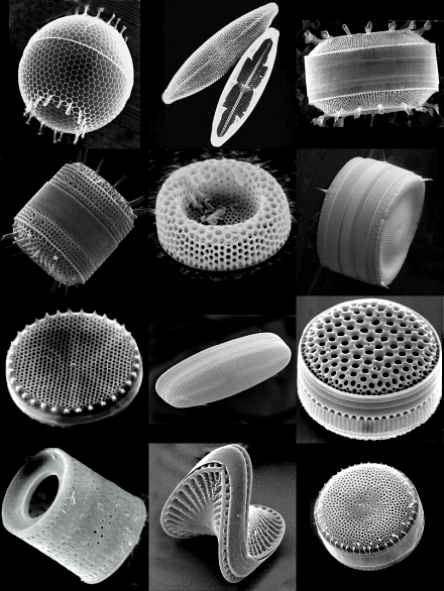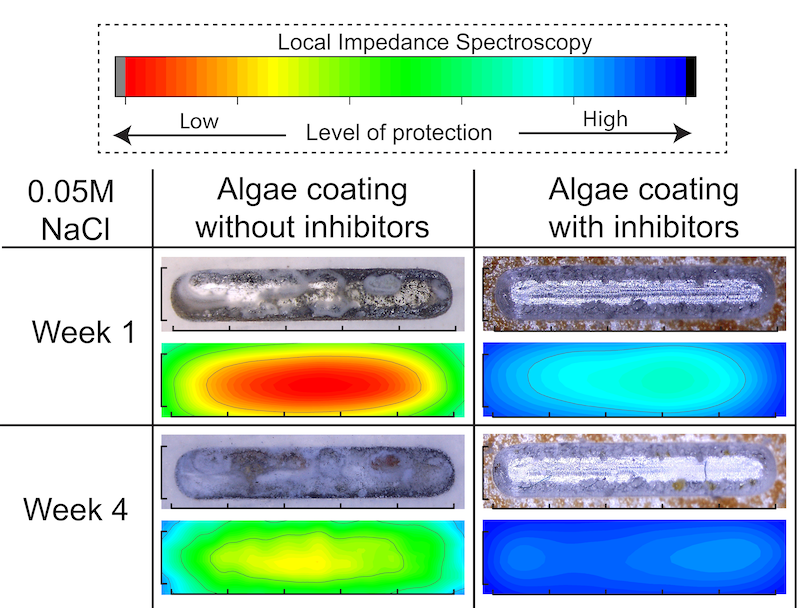What seemed like a wild idea in 2014, using the external skeletons of algae to prevent corrosion, has now been shown to provide long term protection of aluminium used in airplanes. In a few years’ time, it may provide a safe and environmentally-friendly replacement for the use of chromium-6.
“Because of its toxicity, the European Commission has forbidden the use of chromium-6,” says Paul Denissen, PhD researcher in the Novel Aerospace Materials group at the faculty of Aerospace Engineering. “Use of chromium-6 is only still tolerated in situations where good alternatives are lacking, for example to protect airplanes against corrosion.” He explains that the aluminium alloy most used in aviation is especially susceptible to corrosion because of the copper that has been added to increase material strength. Typically, multiple boundary layers are applied to protect this aluminium against weathering. One of these layers is a primer coating loaded with chromium-6. “Our research focusses on using the external skeletons of a sort of algae to develop an environmentally friendly alternative for the use of chromium-6 in this layer.”
Challenging chromium-6
Chromium-6 is a so-called active corrosion-inhibitor. When a treated surface is damaged, for example by scratching, the chromium-6 atoms will be released from the primer layer. They will create a thin layer of chromium oxide on the exposed metal surface, preventing further corrosion. After their release, chromium-6 atoms can continually redistribute themselves, providing continuous protection of the damaged area. “There are a number of alternative corrosion-inhibitors that are also very good at creating a protective barrier,” Denissen explains. “Unlike chromium-6, however, they can oxidize only once, and the protective layer they create is not permanent. Long-term protection therefore requires the continuous release of these inhibitors. More importantly, these alternative inhibitors may already chemically react with the primer coating at the time of its fabrication or application, thereby weakening their anti-corrosive power.” Quite some challenges to overcome, with a possible solution coming from the world of algae.
Various shapes of the external skeleton of diatom algae
Source: https://paleonerdish.files.wordpress.com/2013/06/diatoms.jpg
Pill-box protection
Diatoms are a group of microalgae that have been roaming the earth for more than 100 million years. These single cell organisms come in various sizes, ranging from one to a few tens of micrometres. They have a hard, inorganic shell to protect them from the environment. This cell wall is made out of silica, the same material as glass, and contains many nanometre-sized pores. Inspired by the pill-box shape of these shells (see figure), it was Santiago Garcia, associate professor in the same group and the supervisor of Denissen, who came up with the idea to use them for active corrosion protection in coatings. Garcia explains that “my idea was to fill these shells with alternative corrosion-inhibitors, and then add these loaded shells to the primer coating. I envisioned the pill-box structure to prevent the unwanted chemical reaction between inhibitors and coating.” He also imagined the pores to allow the immediate and sustained release of these inhibitors when the protective layers are damaged, and the metal surface is exposed. “And these algae shells are easily available at low-cost,” Denissen adds.
Rapid development
Denissen explains that his 2015 master’s thesis was merely a feasibility study, to see if this approach could be successful. “Now, we are three years into my PhD and despite limited resources we have just shown corrosion protection potentially equalling that of chromium-6. We still use our first pick of algae shells, but we have substantially increased their filling with inhibitors as well as their release efficiency, leading to a much-improved protection.”
Testing in Paris
After intensive work in Delft to proof the concept, the researchers travelled to Paris for a challenging experiment. “We were curious as to the long-term protective power of our coating for large damages, as required by several companies,” Denissen says. Together with their collaborators from the group of Polina Volovich at Chimie ParisTech, they applied a 1 mm wide scratch to samples of aluminium used for airplanes, covered in a variety of their test ‘algae-coatings’. These samples were subsequently immersed in large volumes of a highly corrosive environment. The researchers got what they bargained for (see figure). “We were astounded,” continues Denissen, “what we saw was full protection against corrosion, even after thirty days of immersion. Only a couple of alternative solutions come this close to the results obtained with chromium-6. It’s an amazing result after only such a short period of development.”
Visualising corrosion protection
Denissen and Garcia have also developed a novel method to study the onset and development of corrosion. It allowed them to gain a detailed understanding of the results they obtain with their algae shells, guiding further optimisation. “It is relatively simple technology, using a basic optical camera,” Garcia explains. “Optical techniques have traditionally been used to obtain qualitative information or to make beautiful pictures. What we have shown is that optics can be used to monitor and quantify local corrosion processes at a very high resolution, in real time. It is mature technology, allowing us to analyse any coating, commercially available or still in development.”
Optimal protection
“We use our experimental findings to build a computer model for further optimization of our coatings,” Denissen says. This can prove very beneficial as these algae shells come in more than 100.000 sizes and shapes. And there are more variables to tune, such as the type of corrosion-inhibitor used, whether or not to add an outside layer to the algae shell to even better regulate inhibitor release, or the optimal concentration of shells in the coating. “We may for example want to use disc-shaped shells to reduce our protective layer to the thickness currently used by the industry,” Denissen explains. “We are also looking into using combinations of inhibitors and shells in our coatings, further improving corrosion protection.”
A small revolution
It is not an easy task to replace chromium-6. “There are many barriers, resulting in a lack of good alternatives,” Denissen says. “For example, the Dutch Ministry of Defence wants proof that alternatives will provide twenty-year protection of their military equipment. But there are no good methods to accelerate this evaluation, to validate it in only a limited time-span.” More importantly, he explains, many of the tests used to validate the efficiency of new coating materials are designed specifically for chromium-6. “It is not a level playing field. It means that you have to prove your alternative coating to behave similar to chromium-6, rather than prove that it provides adequate protection.” Nevertheless, a small revolution has recently taken place. Rather than waiting for coating manufacturers to replace chromium-6, airplane manufacturers are now actively developing their own solutions as well. “At the moment, we are already talking to both.”
Future perspective
Despite very promising results, Denissen stresses that “we need a few more years to develop and demonstrate our algae-based coating before it can be used on planes, bridges or any metal surface that needs protection against corrosion. Does our coating protect sufficiently against scraping and scratching? Can it withstand frequent variations in outside temperature? Will it bond well with the other protective layers?” Garcia adds that “our main commitment is to find solutions to societal problems. We are currently talking to several industry partners about collaboration. Together we can speed up the development and launch of our technology and we expect to be ready for operational experiments by 2022, on an airplane.” Until completion of those experiments and passing the required certifications, the airplane industry may require the European Commission to again extend its leniency, tolerating the use of chromium-6 for the time being.
You can find scientific publications, related to this research, here in Corrosion Science and in Electrochimica Acta.

